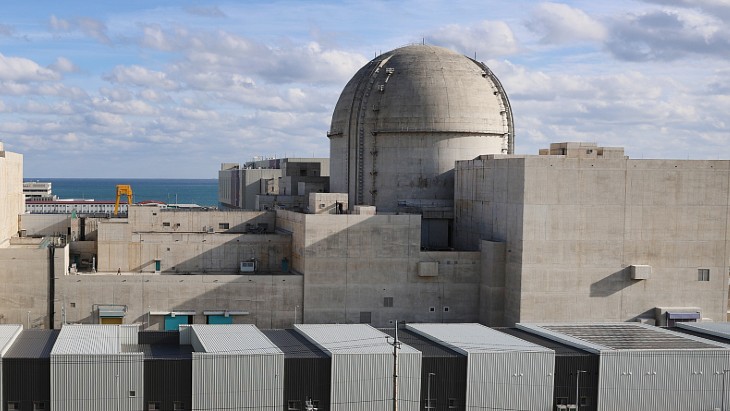Russia is making progress with its plan to build the BREST-OD-300 reactor - part of its 'Proryv', or Breakthrough, project that aims to develop fast reactors with a closed fuel cycle. BREST is the Russian acronym for 'fast reactor with lead coolant'.
Atomproekt said yesterday that it is preparing the "primary working papers" required to start building the reactor. Atomproekt is part of Atomenergomash, the engineering subsidiary of state nuclear corporation Rosatom.
Developed by the N A Dollezhal Research and Development Institute of Power Engineering (NIKIET), BREST-OD-300 is to be built at the site of Siberian Chemical Combine (SCC), in Sversk, near Tomsk. NIKIET and SCC are also Rosatom subsidiaries.
Working documentation for preparation of the site and construction of the reactor will be prepared this year, along with a preliminary report on the safety aspects of the project. In addition, papers required for a construction licence application are also to be prepared, Atomproekt said.
Selected as general designer for the BREST-OD-300 project in August 2013, Atomproekt said yesterday that the reactor is expected to start operations in 2022.
Three phases
The pilot demonstration power complex (PDPC) comprises three phases - the fuel fabrication/re-fabrication module, a nuclear power plant with a BREST-OD-300 reactor, and used nuclear fuel reprocessing module. In April 2014 the fuel fabrication/re-fabrication module was approved by the State Expert Review Authority of Russia, or Glavgosekspertiza. NIKIET finished the BREST design in 2014, to allow construction over 2016-20. If it is successful as a 300 MWe unit, a 1200 MWe (2800 MWt) version will follow.
Vyacheslav Pershukov, head of design for the Proryv project, said in an SCC statement yesterday that the design stage of the PDPC had entered the final phase. "We are already starting to think not only about construction of the fuel fabrication module, but also about the coherence of all three phases and their interaction," said Pershukov, who is a Rosatom deputy director general and the director of the corporation's innovation management unit.
Pershukov stressed that the pace of implementation of the Proryv project was "impressive", adding there was no project of its type anywhere else in the world. "Ahead of us is the wait for licensing and the expansion of construction of the Brest-300 reactor," he said. In 2016, SCC will also complete its "final examination" of the reprocessing module, he added, and make a final decision on the start of its construction.
The preliminary stage of construction of the nitride fuel fabrication/re-fabrication module started in August 2014, SCC noted, and its commissioning is planned for 2017-2018. Construction of the reactor unit - which SCC describes as the second stage in the creation of the PDPC - is scheduled for completion in 2020. The third stage, it said, "will be construction of another plant - a module for the reprocessing of used nuclear fuel." SCC aims to complete the Proryv project by 2023.
Fast reactor strategy
Starting in 2020-25 it is envisaged that fast neutron power reactors will play an increasing role in Russia, though these will probably be new designs such as BREST with a single core and no blanket assembly for plutonium production.
The 300 MWe demonstration unit will use dense nitride uranium-plutonium fuel with lead as the primary coolant. The inherently safe reactor would be part of a closed nuclear fuel cycle, recycling used fuel indefinitely using on-site reprocessing and associated facilities. Longer-term plans foresee the 300 MWe unit as the forerunner to a 1200 MWe version for wide deployment as a commercial power generation unit. The development program is part of an Advanced Nuclear Technologies Federal Program 2010-2020 that seeks to exploit fast reactors as a way to be vastly more efficient in the use of uranium while 'burning' radioactive substances that otherwise would have to be disposed of as waste.
Proceeding with the BREST-OD-300 project depended on successful testing of the nitride fuel in the BN-600 reactor from the end of 2013.
The Beloyarsk 4 BN-800 fast reactor designed by OKBM Afrikantov is intended to replace the BN-600 unit 3 at the Beloyarsk nuclear power plant, in the Sverdlovsk district. The BN-800 unit first started up in June 2014, with first power to the turbine in November 2015. It is 864 MWe gross, 789 MWe net, and is essentially a demonstration unit for fuel and design features for the BN-1200. Detailed design completion of the BN-1200 reactor, also being developed by OKBM Afrikantov, is expected in 2017.
A pilot 100 MWe SVBR-100 unit is planned to be built next to the Research Institute of Atomic Reactors (RIAR), in Dimitrovgrad by AKME-Engineering by about 2017. This is a modular lead-bismuth cooled fast neutron reactor design from OKB Gidropress, and is intended to meet regional needs in Russia and abroad.
Russia is also developing a multipurpose sodium-cooled fast neutron research reactor, or MBIR by its Russian acronym, at the RIIAR site. Regulator Rostechnadzor issued a construction licence for MBIR in May last year. MBIR will replace RIAR's BOR-60, which is the world's only fast research reactor in operation.
Researched and written
by World Nuclear News




_72306.jpg)


_49562.jpg)





